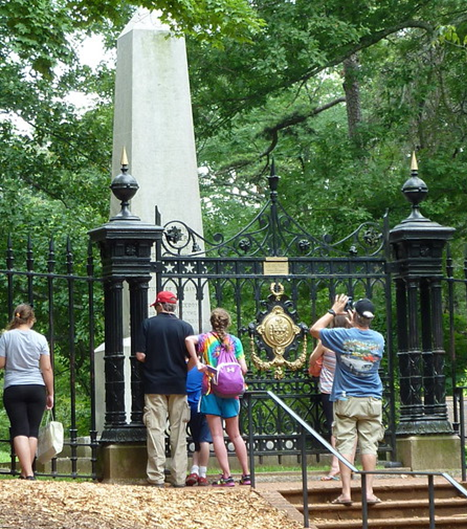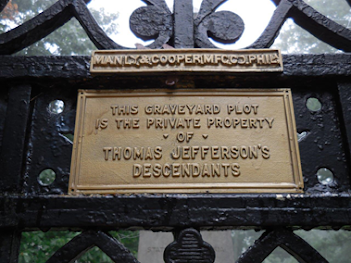June 2023
Saving Monticello: The Newsletter
The latest about the book, author events, and more
Newsletter Editor - Marc Leepson
Volume XX, Number 6 June 2023
“The study of the past is a constantly evolving,never-ending journey of discovery.” – Eric Foner

IN HALLOWED REPOSE: Visitors to Monticello who take in the fenced-in Jefferson familygraveyard about 2,000 feet from the house often presume that the small cemeteryconveyed with the property when Jefferson’s heirs sold Monticello. But that isnot the case.
The graveyard, containing Thomas Jefferson’sgravesite and plots of many of his descendants and their families, was retainedby the family after they sold Monticello to James Turner Barclay in 1831, fiveyears after his death. The family continued to maintain and preserve the graveyardafter Barclay sold Monticello to Uriah Levy in 1834, when Jefferson Monroe Levytook control in 1879, and when he sold the property to the Thomas JeffersonMemorial Foundation in 1923.
 Since 1913, the graveyard has come underthe purview of the Monticello Association, a nonprofit founded that year. Mostof its members are lineal descendants of Thomas Jefferson.
Since 1913, the graveyard has come underthe purview of the Monticello Association, a nonprofit founded that year. Mostof its members are lineal descendants of Thomas Jefferson. Which brings us to a bit of drama surrounding Thomas Jefferson’sgrave that I just learned about—although it happened in 1882. I discovered itwhile searching the Library of Congress’ Chronicling America historic newspaperarchive, which contains hundreds of thousands of searchable digitized images ofnewspapers (mainly, but not exclusively, small and medium-sized city newspapers)from 1770-1963.
As I was searching for potential materialto use in this newsletter, I happened upon a few articles about a kerfuffle instigatedin 1882 by Thomas Jefferson’s oldest surviving grandchild, Septimia, so named becauseshe was the seventh (and last) daughter of Thomas Jefferson’s daughter MarthaRandolph and her husband Thomas Mann Randolph.
Septimia Anne Randolph, was born on January 3, 1814, and grew up at Monticello. Notlong after Thomas Jefferson died in 1826, she moved to Boston with her motherand younger brother George where she continued her education at the home of herolder sister Ellen, who had married Joseph Coolidge and moved north with him toMassachusetts.
Septimiaspent the next ten years living with relatives and family friends back home inVirginia, in Washington, D.C., Louisiana, Florida, and in Havana, Cuba. Whilein Havana, she met a Scottish doctor, David Scott Meikleham. They married onAugust 13, 1838, at the Randolph family’s Edgehill Plantation near Monticello,then moved to Havana.
The couplesettled in New York City, where Dr. Meikleham practiced medicine until hisdeath on November 20, 1849. His early demise was a financial burden to Septimiaand her four children. To make ends meet, she ran a boardinghouse, then left NewYork to return to Edgehill, and then moved to Washington, D.C., where she lived,as one newspaper reported, with three of her “middle-aged” children “in ahumble cottage” in Georgetown, “which rents for $20 a month.” She died in Washingtonat age 73, on September 14, 1887.
Septimia Meikleham (in portrait below) made national headlines in thespring of 1882 when she announced that, as Jefferson’s oldest directdescendant, she’d decided that her grandfather’s remains should be disinterredfrom the family gravesite on the mountaintop in Charlottesville and reburied inGlenwood Cemetery in Northeast Washington, D.C. Glenwood, not far from the present-day WashingtonHospital Center, is the site ofthe early 19th century Clover Hill Farm, which became a cemetery in1854 and remains one today.

The reason for the move, Septimia said, wasthat the Monticello graveyard had “passed out of control of the family” threeyears earlier, in 1879, when Jefferson Monroe Levy settled a family lawsuitover Uriah Levy’s will and took ownership of the property. That simply was nottrue as the graveyard never conveyed with the property and remained in thehands of the descendants of her brother, Thomas Jefferson Randolph.Nevertheless, the Glenwood Cemetery Board of Trustees agreed to acceptJefferson’s remains at its June 1882 annual meeting.
The backlash came a few days after the meetingwhen the heirs of Thomas Jefferson Randolph (who had died in 1875), theco-executor of his grandfather’s will, hired an attorney to oppose the move.The heirs “will not allow Jefferson’s remains to be moved to another cemetery,”the attorney wrote to the Glenwood board. He also pointed out that thegraveyard did not convey with the sale of Monticello, and that T.J. Randolph’s heirs—notSeptimia—owned and managed the site.
To his credit, Jefferson Monroe Levy spokeout forcefully against Septimia Meikleham’s proposal. He was quoted at length in several newspapers giving the historyof the graveyard and making it clear he strongly opposed moving the ThomasJefferson’s remains from the place where he let it be known he wanted to restin peace.
“The spot where Jefferson was buried wasselected by himself,” Levy said, “and there are peculiar reasons why his wishesshould be respected. When Jefferson and [his close friend and brother-in-law]Dabney Carr were young men, they made an agreement that whichever of them shoulddie first should be buried by the survivor under a certain oak tree atMonticello, which was a favorite with them both.
“Dabney Carr died in France, in the time ofthe Revolutionary War, and after the war was over, Jefferson, in accordancewith his agreement, had the body of Carr brought to this country and buriedunder the oak. When Jefferson died, he expressed in his will his desire to beburied in the same secluded spot beside his friend. He also left directions asto the monument to be erected over him.
“His wife and children were buried in thesame spot of ground. The Randolph family has used it as burying ground eversince.”

Newspapers throughout the country agreedwith the other descendants and with Jefferson Levy, and editorialized againstthe move, some of them intimating that Septimia pushed for the move forfinancial gain. The St. Paul (Minnesota) DailyGlobe, for example, editorialized on June 18, 1882, that Thomas Jefferson had“the wish that his remains might rest forever undisturbed, and it was only leftfor modern, mercenary ghouls to prepose to desecrate the hallow burial lot atMonticello.”
The editorial concluded: “Would itbe anything short of sacrilege to remove from ground so hallowed, selected byhimself, for any purpose, and especially for a mercenary one, the remains ofthe venerated patriot, philosopher and statesman? Let the remains restundisturbed, in hallowed repose, ‘until the last syllable of recorded time.’”
The Glenwood Board took the hint anddropped the matter.
HOUSE HISTORY NO. 2: If yougo to the University of Virginia Press Fall 2023 catalog online and scroll downthe left side, you’ll get a preview of my next book. Huntland: The Historic Virginia Country House, the Property, and ItsOwners, which will be coming out in August. It’s my tenth book and mysecond house history, along the lines of SavingMonticello. Huntland, in Middleburg, Virginia, was built in 1834, andcertainly has lots of history, memorable owners, and a triumphant 21stcentury historic preservation story. Stay tuned for more details.
Here’sthe link for the U-Va. Press Fall Catalog; https://www.upress.virginia.edu/fall23.pdf
EVENTS: Just one in June, a talk on my only Civil War book, Desperate Engagement, the story of thelittle-known but crucial July 11, 1864, Battle of Monocacy near Frederick,Maryland, and Confederate Gen. Jubal Early’s subsequent attack on Washington,D.C., that takes place on Saturday, June17, for the Alexandria (Va.) Civil War Roundtable.
For details on other upcoming events, checkthe Events page on my website: https://bit.ly/NewAppearances
GIFT IDEAS: For a personally autographed, brand-new paperback copy of Saving Monticello, please e-mail marcleepson@gmail.com I also have a few as-new, unopened hardcovercopies, along with a good selection of new copies of my other books: Flag: An American Biography; DesperateEngagement; What So Proudly We Hailed; Flag:An American Biography; and Ballad ofthe Green Beret: The Life and Wars of Staff Sgt. Barry Sadler.



